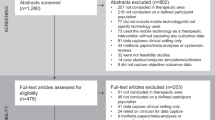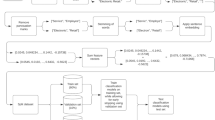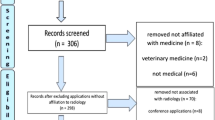Abstract
The possible effect of radiofrequency exposure from mobile phones on tumor risk has been studied since the late 1990s. Yet, empirical information about recall of the start of mobile phone use among adult cases and controls has never been reported. Limited knowledge about recall errors hampers interpretations of the epidemiological evidence. We used network operator data to validate the self-reported start year of mobile phone use in a case–control study of mobile phone use and acoustic neuroma risk. The answers of 96 (29%) cases and 111 (22%) controls could be included in the validation. The larger proportion of cases reflects a more complete and detailed reporting of subscription history. Misclassification was substantial, with large random errors, small systematic errors, and no significant differences between cases and controls. The average difference between self-reported and operator start year was −0.62 (95% confidence interval: −1.42, 0.17) years for cases and −0.71 (−1.50, 0.07) years for controls, standard deviations were 3.92 and 4.17 years, respectively. Agreement between self-reported and operator-recorded data categorized into short, intermediate and long-term use was moderate (kappa statistic: 0.42). Should an association exist, dilution of risk estimates and distortion of exposure–response patterns for time since first mobile phone use could result from the large random errors in self-reported start year. Retrospective collection of operator data likely leads to a selection of “good reporters”, with a higher proportion of cases. Thus, differential recall cannot be entirely excluded.
This is a preview of subscription content, access via your institution
Access options
Subscribe to this journal
Receive 6 print issues and online access
$259.00 per year
only $43.17 per issue
Buy this article
- Purchase on Springer Link
- Instant access to full article PDF
Prices may be subject to local taxes which are calculated during checkout



Similar content being viewed by others
References
Ahlbom A, Feychting M, Green A, Kheifets L, Savitz DA, Swerdlow AJ . Epidemiologic evidence on mobile phones and tumor risk: a review. Epidemiology 2009; 20: 639–652.
Interphone study group. Brain tumour risk in relation to mobile telephone use: results of the INTERPHONE international case-control study. Int J Epidemiol 2010; 39: 675–694.
Interphone study group. Acoustic neuroma risk in relation to mobile telephone use: Results of the INTERPHONE international case-control study. Cancer Epidemiol 2011; 35: 453–464.
Swerdlow AJ, Feychting M, Green AC, Leeka Kheifets LK, Savitz DA . Mobile phones, brain tumors, and the interphone study: where are we now?. Environ Health Perspect 2011; 119: 1534–1538.
Auvinen A, Hietanen M, Luukkonen R, Koskela RS . Brain tumors and salivary gland cancers among cellular telephone users. Epidemiology 2002; 13: 356–359.
Schuz J, Steding-Jessen M, Hansen S, Stangerup SE, Caye-Thomasen P, Poulsen AH et al. Long-term mobile phone use and the risk of vestibular schwannoma: a Danish nationwide cohort study. Am J Epidemiol 2011; 174: 416–422.
Benson VS, Pirie K, Schuz J, Reeves GK, Beral V, Green J . Mobile phone use and risk of brain neoplasms and other cancers: prospective study. Int J Epidemiol 2013; 42: 792–802.
Frei P, Poulsen AH, Johansen C, Olsen JH, Steding-Jessen M, Schuz J . Use of mobile phones and risk of brain tumours: update of Danish cohort study. BMJ 2011; 343: d6387.
Benson VS, Pirie K, Schuz J, Reeves GK, Beral V, Green J . Authors' response to: The case of acoustic neuroma: comment on mobile phone use and risk of brain neoplasms and other cancers. Int J Epidemiol 2013; 43: 275.
Hardell L, Carlberg M, Hansson Mild K . Case-control study on cellular and cordless telephones and the risk for acoustic neuroma or meningioma in patients diagnosed 2000-2003. Neuroepidemiology 2005; 25: 120–128.
Hardell L, Carlberg M, Soderqvist F, Mild KH . Case-control study of the association between malignant brain tumours diagnosed between 2007 and 2009 and mobile and cordless phone use. Int J Oncol 2013; 43: 1833–1845.
Hardell L, Hallquist A, Mild KH, Carlberg M, Pahlson A, Lilja A . Cellular and cordless telephones and the risk for brain tumours. Eur J Cancer Prev 2002; 11: 377–386.
Vrijheid M, Armstrong BK, Bedard D, Brown J, Deltour I, Iavarone I et al. Recall bias in the assessment of exposure to mobile phones. J Expo Sci Environ Epidemiol 2009; 19: 369–381.
AGNIR (The Health Protection Agency's Independent Advisory Group on Non-ionising Radiation). Health effects from radiofrequency electromagnetic fields: report of the independent advisory group on non-ionizing radiation. Health Protection Agency: Chilton, Oxforshire, UK, 2012.
Olivero WC, Lister JR, Elwood PW . The natural history and growth rate of asymptomatic meningiomas: a review of 60 patients. J Neurosurg 1995; 83: 222–224.
Thomsen J, Tos M . Acoustic neuroma: clinical aspects, audiovestibular assessment, diagnostic delay, and growth rate. Am J Otol 1990; 11: 12–19.
Pettersson D, Mathiesen T, Prochazka M, Bergenheim T, Florentzson R, Harder H et al. Long-term mobile phone use and acoustic neuroma risk. Epidemiology 2014; 25: 233–241.
Palmisano S, Schwartzbaum J, Prochazka M, Pettersson D, Bergenheim T, Florentzson R et al. Role of tobacco use in the etiology of acoustic neuroma. Am J Epidemiol 2012; 175: 1243–1251.
Aydin D, Feychting M, Schuz J, Andersen TV, Poulsen AH, Prochazka M et al. Impact of random and systematic recall errors and selection bias in case–control studies on mobile phone use and brain tumors in adolescents (CEFALO study). Bioelectromagnetics 2011; 32: 396–407.
Aydin D, Feychting M, Schuz J, Andersen TV, Poulsen AH, Prochazka M et al. Predictors and overestimation of recalled mobile phone use among children and adolescents. Prog Biophys Mol Biol 2011; 107: 356–361.
Vrijheid M, Cardis E, Armstrong BK, Auvinen A, Berg G, Blaasaas KG et al. Validation of short term recall of mobile phone use for the Interphone study. Occup Environ Med 2006; 63: 237–243.
Funch DP, Rothman KJ, Loughlin JE, Dreyer NA . Utility of telephone company records for epidemiologic studies of cellular telephones. Epidemiology 1996; 7: 299–302.
Heinavaara S, Tokola K, Kurttio P, Auvinen A . Validation of exposure assessment and assessment of recruitment methods for a prospective cohort study of mobile phone users (COSMOS) in Finland: a pilot study. Environ Health 2011; 10: 14.
Berg G, Schuz J, Samkange-Zeeb F, Blettner M . Assessment of radiofrequency exposure from cellular telephone daily use in an epidemiological study: German Validation study of the international case-control study of cancers of the brain–INTERPHONE-Study. J Expo Anal Environ Epidemiol 2005; 15: 217–224.
Inyang I, Benke G, Morrissey J, McKenzie R, Abramson M . How well do adolescents recall use of mobile telephones? Results of a validation study. BMC Med Res Methodol 2009; 9: 36.
Parslow RC, Hepworth SJ, McKinney PA . Recall of past use of mobile phone handsets. Radiat Prot Dosimetry 2003; 106: 233–240.
Samkange-Zeeb F, Berg G, Blettner M . Validation of self-reported cellular phone use. J Expo Anal Environ Epidemiol 2004; 14: 245–248.
Shen C, Bao WM, Yang BJ, Xie R, Cao XY, Luan SH et al. Cognitive deficits in patients with brain tumor. Chin Med J (Engl) 2012; 125: 2610–2617.
Birkett NJ . Effect of nondifferential misclassification on estimates of odds ratios with multiple levels of exposure. Am J Epidemiol 1992; 136: 356–362.
Blair A, Stewart P, Lubin JH, Forastiere F . Methodological issues regarding confounding and exposure misclassification in epidemiological studies of occupational exposures. Am J Ind Med 2007; 50: 199–207.
Pearce N, Checkoway H, Kriebel D . Bias in occupational epidemiology studies. Occup Environ Med 2007; 64: 562–568.
Wacholder S . When measurement errors correlate with truth: surprising effects of nondifferential misclassification. Epidemiology 1995; 6: 157–161.
Acknowledgements
This study was funded by the Swedish Council for Working Life and Social Research. We thank the Regional Cancer Registers for their collaboration.
Author information
Authors and Affiliations
Corresponding author
Ethics declarations
Competing interests
MF is co-investigator of the COSMOS cohort study, funded by the Swedish Research Council, the Swedish Council for Working Life and Social Research, AFA Insurance and VINNOVA (The Swedish Governmental Agency for Innovation Systems). VINNOVA received funds for this purpose from TeliaSonera, Ericsson AB and Telenor. The provision of funds to the COSMOS study investigators via VINNOVA is governed by agreements that guarantees COSMOS’ complete scientific independence. MF is vice chairman of the International Commission on Non-Ionizing Radiation Protection, an independent body setting guidelines for non-ionizing radiation protection. She serves as an advisor to a number of national and international public advisory and research steering groups concerning the potential health effects of exposure to non-ionizing radiation.
Rights and permissions
About this article
Cite this article
Pettersson, D., Bottai, M., Mathiesen, T. et al. Validation of self-reported start year of mobile phone use in a Swedish case–control study on radiofrequency fields and acoustic neuroma risk. J Expo Sci Environ Epidemiol 25, 72–79 (2015). https://doi.org/10.1038/jes.2014.76
Received:
Revised:
Accepted:
Published:
Issue Date:
DOI: https://doi.org/10.1038/jes.2014.76



